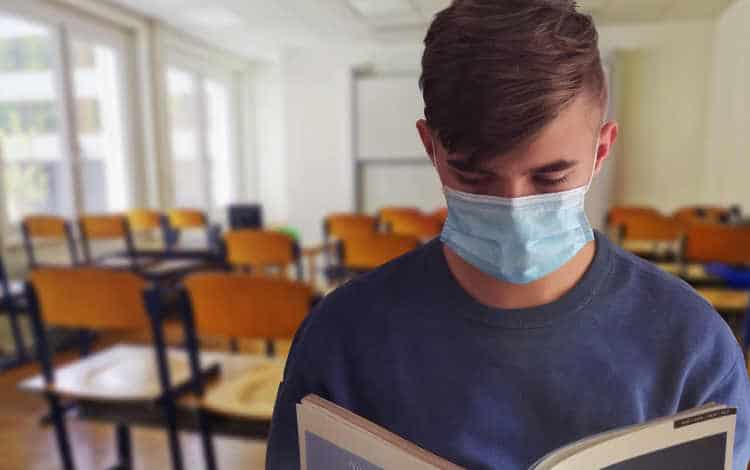
Almost a year into the COVID-19 pandemic, life is creeping back to normal, but it’s still far from what it was in early March 2020.
Masks are a part of daily life, restaurants and stores are still operating at limited capacity, and live sports, music, and theater are still months away from returning.
Education and schools are also still a long way from returning to a pre-pandemic level of normalcy.
Although more students are returning to the classroom every day, the experience is far from what most are used to.
And all of the changes, from classroom arrangements and hybrid learning plans to the actual classroom arrangements, not to mention concerns about the virus itself, have increased anxiety among both students and teachers.
Prior to COVID-19, anxiety was an issue of growing concern among educators. The Child Mind Institute reported a 17 percent increase in anxiety in children from 2009 to 2019.
However, studies conducted in 2020 indicate that the number of children experiencing symptoms of anxiety and depression during COVID has more than doubled.
Anxiety in children can present in a number of ways, but for many children, one of the first signs of trouble are problems at school, both in terms of academic performance and behavior.
Although teachers are experienced in child development and psychology, which form the foundation of education programs (check out the education department at the University of Arizona Global Campus at www.uagc.edu for an example of a teacher education program), the pandemic has challenged even the most experienced educators.
Weekly Featured Book:
Enjoy Inner Peace in the Busy Daily Life
That doesn’t mean teachers cannot help their students manage their anxiety. By keeping a few basic ideas in mind and using them in your everyday interactions with students, you can help support their mental health both now and in the long term.
Simple Tips to Help Students Feel Supported
COVID-19, and the uncertainty that comes with it has many students feeling scared, isolated, lonely, and frustrated – much like adults.
Combined with your own feelings about the pandemic and concerns about the well-being of yourself and your family, the idea of focusing on commas and math facts might seem like a minor issue.
However, helping students feel secure and supported requires maintaining a certain level of normalcy, and that includes learning.
Although you may need to adjust your teaching methods to accommodate health protocols, education still matters. Strive for progress, not perfection.
More specifically, some of the things you can do as a teacher:
Implement Mindfulness
Whether you’re teaching online or in person, implementing mindfulness exercises that give students a chance to help refocus their thoughts, ground themselves in the present moment, and reduce their stress.
Anxiety spirals when you feel out of control – a common experience during the pandemic – and mindfulness exercises allow students to regain some control over their feelings. Search for mindfulness exercises you can try online.
Speak in Positive Terms
Regardless of your own feelings about the pandemic, it’s important to speak in positive terms.
No one likes wearing masks, but they help protect everyone’s health. Remind students of the good they are doing when they wear their masks, wash their hands, and practice social distancing.
When students express concerns and fears, validate them, but remind them of the positive strides and progress that’s being made. Focus on how they have been a part of the solution, and praise them for their strength and resilience.
Allow Space to Talk about Feelings
With limited instruction time, you may be reluctant to spend time on other activities.
However, creating a space where students can safely discuss their feelings, and incorporating activities that remind them of their strengths, give them coping skills, help them feel more in control, and can help them manage anxiety and be more open to learning.
Get Outside
When you can, go outdoors. Fresh air and nature are proven to help manage anxiety, and while exercise increases production of endorphins, the so-called happy hormones that produce feelings of well-being.
Depending on your local restrictions, children may also be allowed to remove their masks while outdoors. Even if you are teaching online, encourage students to head outdoors – or even make assignments that require an outdoor element.
Provide Journals
Some children may not be willing to talk about their feelings, or they may not be able to articulate their feelings very well. Giving them journals where they can share their thoughts, concerns, and fears, as well as their wins and positive feelings, provides an outlet.
Although not all children will take to journaling, for some, it will serve as a valuable tool to manage their feelings at this challenging time.
Stay in Touch with Families
Parents are likely to feel as much anxiety and frustration as their children – and you. Make a point of staying in contact and reiterating that you are all on the same team, and work together to support your students.
To be sure, not all students are struggling this year. However, almost everyone has had periods of anxiety.
Being flexible, knowing what to prioritize, and providing loving support will help everyone move forward and be happy and healthy when life returns to normal.


